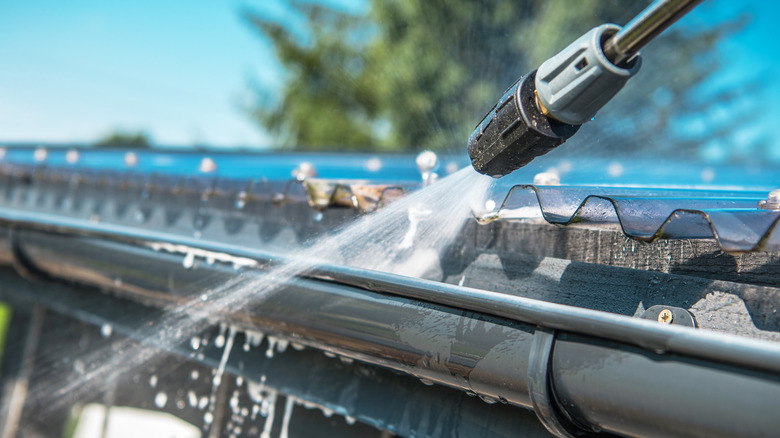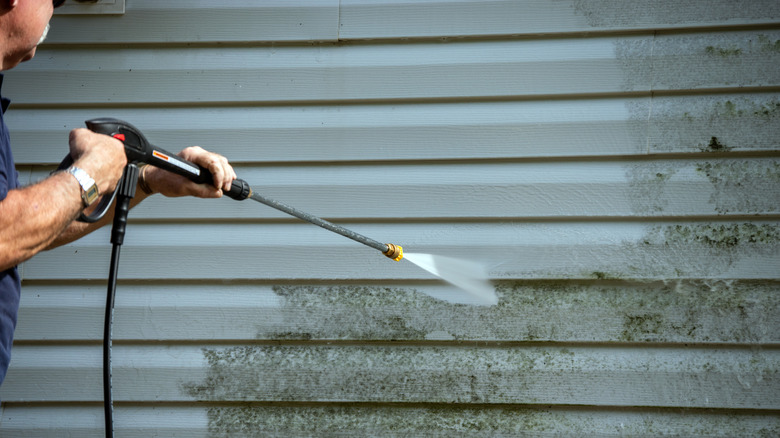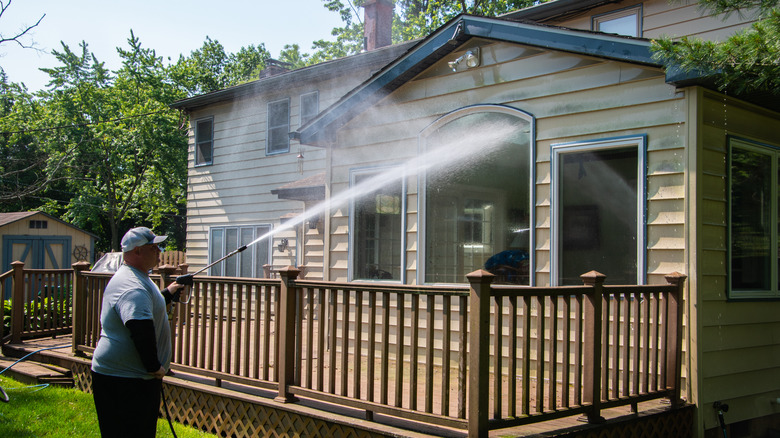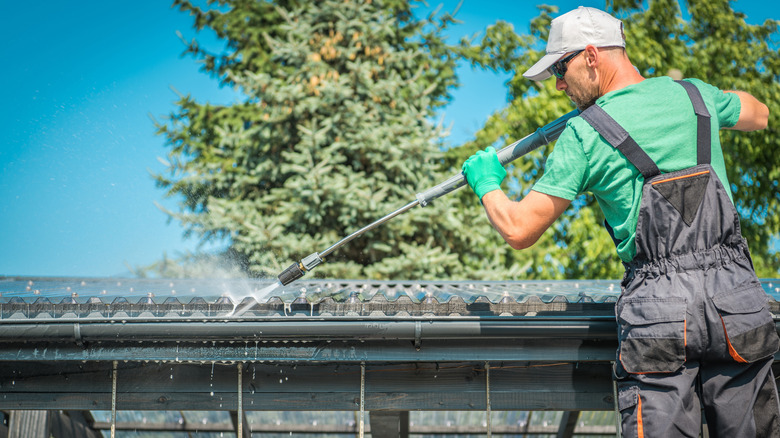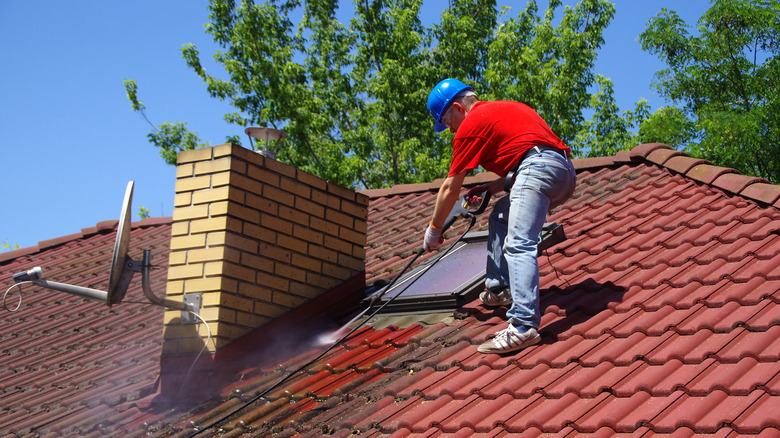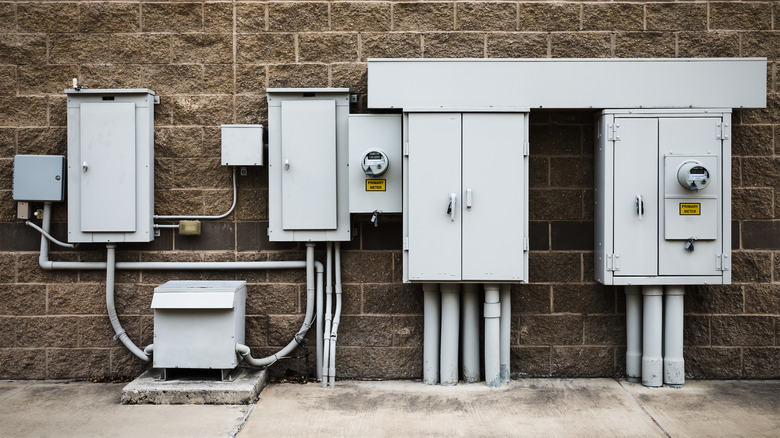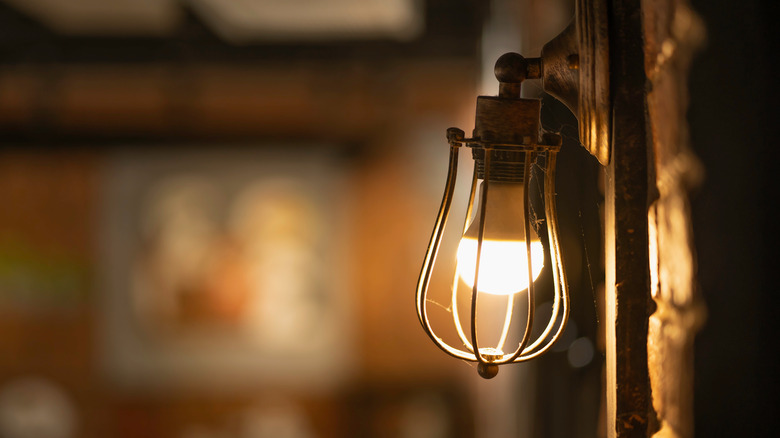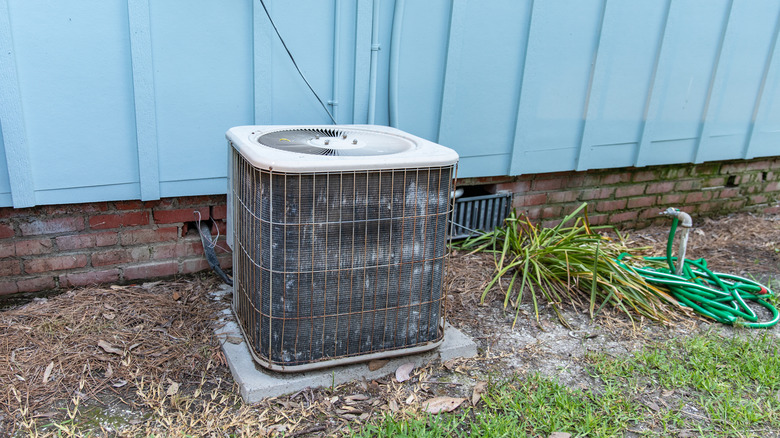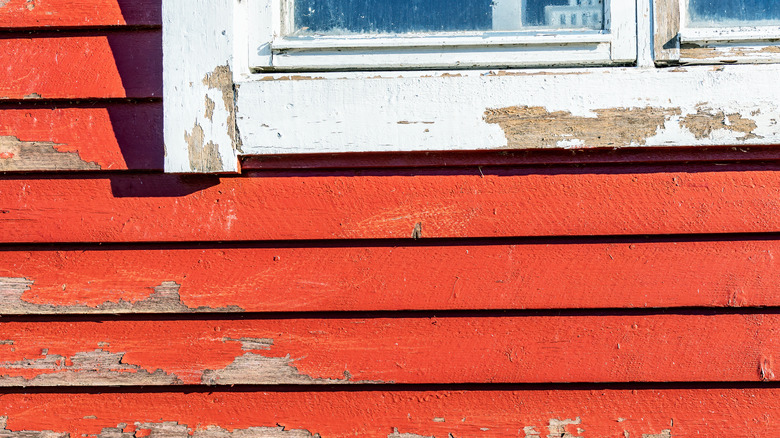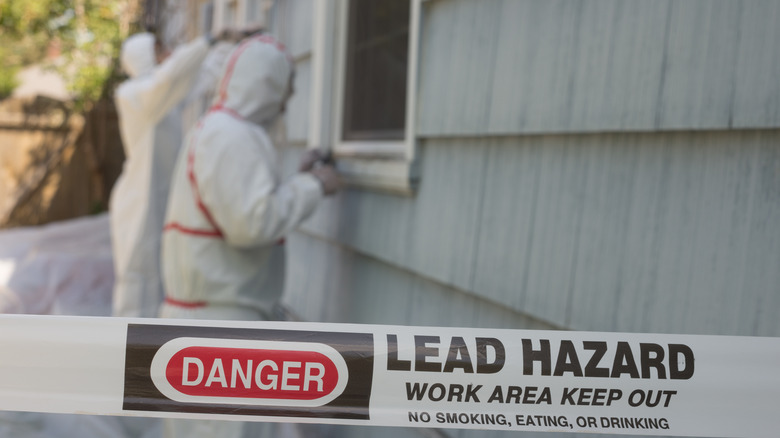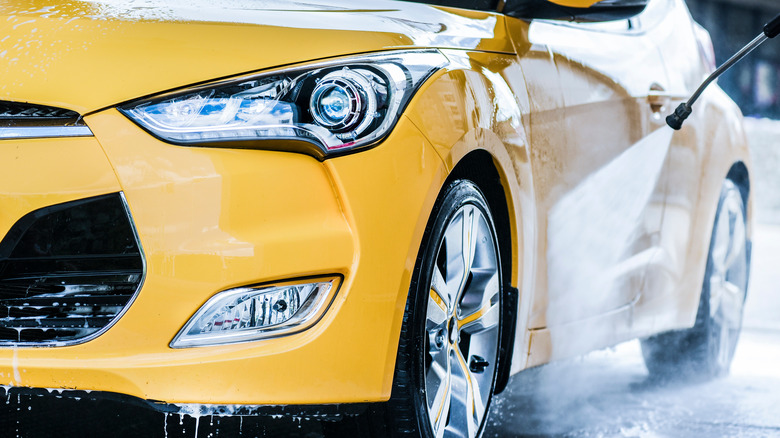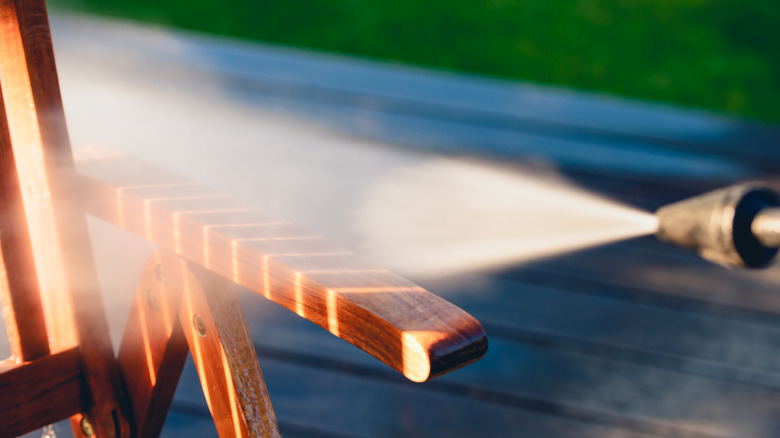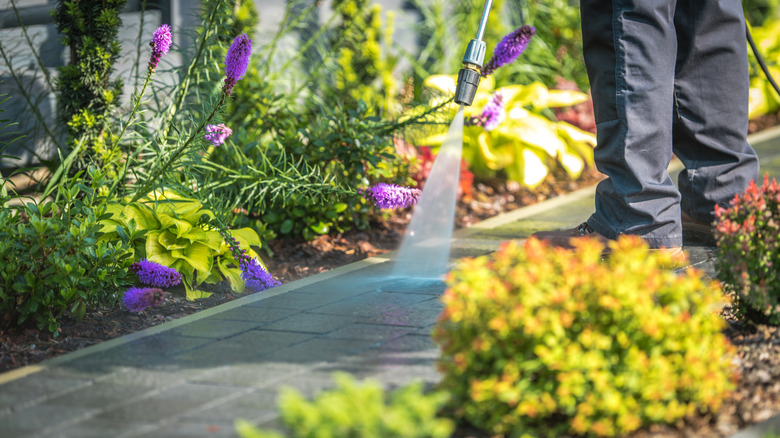Things You Should Never Clean With A Pressure Washer
Pressure washing has been a great boon to DIY-minded homeowners looking for a shortcut to quickly and affordably cleaning things that like to get seriously dirty. Shortcuts and tools (which are often shortcuts in their own right) are among the things that make humans special, but sometimes you can cut things a little too short.
Pressure washers can be a bit like Maslow's hammer: If the best cleaning tool you have is a pressure washer, you tend to see every speck of dirt as an opportunity to pressure wash. But, as you might have guessed from the title, not everything is suitable for the kind of pressure and abrasion a typical consumer power washer is capable of. Of course, there are a near-infinite number of things you shouldn't pressure wash — cats, jewelry, priceless paintings, the moon — but the list of things you're actually likely to try to pressure wash, but shouldn't, is a lot shorter and a lot more surprising.
What matters is the actual amount of pressure your washer brings to bear on its target. Commercial pressure washers typically pump out a lot more force (up to 6900 psi) than consumer models (typically from 1000 to 2900 psi). The same is true of gas versus electric washers. And any one of these devices will have pressure adjustment settings and different nozzle attachments that accomplish much the same. So, to say that something should never be cleaned with a pressure washer is unlikely to be 100% true, but we'll focus on the things that you might choose to pressure wash around your home, but shouldn't in most situations. (Note: We'll be using the terms "pressure washing" and "power washing" interchangeably.)
Wood and vinyl siding
Cleaning the exterior of a home is one of the main reasons people buy pressure washers. And there's no shortage of experts who will tell you it's okay to do just that. But it could be among the worst ideas you'll have as a homeowner.
Water is stronger than you'd guess from your ordinary daily interactions with it pouring from a 60 psi faucet. Fire hoses, for example, operate at about 1200 psi. Home pressure washers can sometimes reach into the 4000 psi range. At higher pressures, water can be used (even without added abrasives) to precisely cut fabrics, rubber, and food. But a standard consumer pressure washer is more than strong enough to splinter the edges of wood and punch through vinyl siding that is weakened by UV exposure or made brittle by cold temperatures.
But probably the most important reason to avoid pressure washing your home is the possibility of getting water beneath siding or inside your walls. Depending on the age and construction of your walls, this could be a major or a minor risk, but it's always a risk. And once the moisture has been pressured into the wall, evaporation is a slow or even impossible process. This can lead to rot and mold growth. You should also take care when pressure washing a brick wall or facade, as loose mortar can be dislodged by the water stream.
Windows
As with siding, it's natural to assume that materials designed to keep water out of your house are safe for pressure washing. But rain doesn't fall at 3000 psi, and thank goodness for that. Windows, of course, can provide pressurized water access to the interior of your walls just as siding can. This is a particular problem with older window installations that might include distressed wood, paint, window glazing, caulk, and other sealants that need to be replaced.
There's also the very real possibility of breaking a window. Experienced users might be able to avoid this by selecting the right nozzle, regulating the pressure, and avoiding hitting the windows at 90 degrees with a stream of pressurized water. You'll also want to take particular care with double-paned windows, as pressurized water can break the seal between layers and create costly damage. Of course, there's a good chance you'll have a go at this anyway. If you do, look into best practices to keep your windows and walls intact, such as the right pressure, the right nozzle, the right angle, and the right procedures to do it as safely as possible.
Gutters
Gutters are obviously meant to handle water with aplomb, and you might assume that since they hold the weight of water they can also handle the pressure of a power washer. Yet, both vinyl and aluminum gutters are susceptible to damage from pressure washers. But perhaps the most important consideration is one that should be a non-negotiable: Do not ever use a pressure washer while standing on a ladder. The force of the pressurized water will unbalance you. How well you handle losing your balance determines how often you will fall off the ladder, not if you will fall. Don't do it.
If you've ever installed or repaired gutters and downspouts, you will find this piece of information old news: They are relatively fragile installations even when done well. You probably wouldn't let your kids climb the downspouts, in part because their weight would potentially damage the installation. Now, consider that a consumer power washer can put pressure on a 1 square inch area roughly equivalent to the weight of a Toyota Corolla. Let's all take a moment to envision how long a Corolla would hang from our gutters before crashing into the flower bed.
Roofs, and especially asphalt shingles
You should never clean asphalt roofing materials with a pressure washer, for a number of reasons. And, in fact, it's probably a good idea to take roofs off of your pressure washing to-do list altogether. This is partly because of immediate safety concerns. You'll probably be cleaning the roof from a ladder or the roof itself, and being on either while thrown off balance by a 3000 psi stream of water is a terrible idea. Scaffolding is better, though you won't have fun falling off of that, either.
The other big problem is that pressure washers can do more damage than good when it comes to roofing materials. The list of possible problems is convincing. Pressure washing tends to strip the granules off of asphalt shingles. Those granules represent a good portion of the protection a shingle has against the elements, and the loss of that protection is basically a roofing emergency. Pressure washing can also damage the asphalt and fiberglass layers of shingles, as well as the adhesive areas that bond shingles together. It can directly damage other types of roofing as well, including slate, tile, and shake roofing materials.
Electrical panels and meters
This might seem as obvious as warning people not to pressure wash a lemon meringue pie, but people do it anyway. You just don't hear much about it because they no longer have power in their homes and so can't complain about it on Reddit. Okay, maybe it's not that bad, but it's still not a good idea.
Electric meter enclosures have a NEMA 3R rating, which means they provide some degree of protection against the ingress of rain. How much protection? In testing, these boxes are subjected to water spray at 5 psi. The worst consumer pressure washer will deliver 400 times that much pressure, and the box manufacturer makes no claims about keeping water out at that pressure. It's not just about meters, either. Other outside electrical enclosures, like disconnects you might use for HVAC and other equipment, have a similar water-resistant (but not watertight or waterproof) rating. And in spite of being described by the National Electric Code as "weatherproof," outdoor outlets admit water pretty easily, especially if they're in use (meaning an electric cord is plugged in, preventing the enclosure's cover from closing). It matters because water can damage electrical components inside of these enclosures, and certainly will cause short-circuits and provide an unexpected path for water to reach you.
Outdoor light fixtures
For many of the same reasons, you'll want to avoid cleaning light fixtures with a pressure washer. This means taking care with spotlights and floodlights mounted to your house, as well as low-voltage and battery- or solar-powered landscape lighting. It might be unusual for anyone to break out the pressure washer because the solar lights lining your garden path have gotten a little mossy; what happens instead is that, while cleaning the pavers along the path, you decide to give the lights a little spray too. Don't.
Outdoor light fixtures often have glass panes and, until fairly recently, were also likely to have glass bulbs. If your home's windows are a little susceptible to breaking by power washers, imagine how much less robust a thin pane of glass designed to keep moths and modest rain showers out is prepared to deal with 2000 psi coming at it. And, to boot, the pressure-driven water is being expelled at an angle not usually managed by pre-apocalypse rain. Low-voltage DC and solar lighting tends to fare even worse, as there are necessarily electronic components somewhere along the power supply path to lighting your walkways.
Air conditioners
Considering the fact that HVAC equipment sits out in the weather year-round, it might be surprising that HVAC units are not suitable for pressure washing. Just as with outdoor electrical fixtures, the explanation is about matters of degree. Rain, and even hail, are unlikely to damage these units, but a pressure washer can — and will do it easily. A quick close-up inspection reveals why.
The soft aluminum or copper fins these appliances use to exchange heat with the environment are extremely fragile, yet carefully spaced apart in order to function properly. Jostle too many of those around and you no longer have an AC that works efficiently. Similarly, the tubing that carries refrigerant at different pressures throughout the HVAC system can be eroded, punctured, or broken by a jet of water from a pressure washer, which leaves you with an air conditioner that no longer works at all until you've called someone out to make a costly repair.
Painted surfaces
The one time you can pressure wash a painted surface safely is when you're trying to remove the paint from it. Otherwise, it's best to keep pressure washers and paint away from each other. They will obviously remove paint, and that's exactly why some house painters use pressure washers. A telling thing happens after the paint is removed, but before the washing ends. Experts advise that you wait three to four days before painting pressure-washed walls to give the wood time to dry out enough to receive paint properly. That is, your house's wood is now absorbing enough water as a result of pressure washing that it takes up to four dry days to get rid of the moisture. This is not the state you want your house paint to be in, of course.
Pressure washing isn't just a problem for painted wood. You can readily remove paint from concrete surfaces as well, and even from grills and other apparently super-durable things around the home. Keep a close eye on the condition of the paint and the underlying surface; even apparently perfect paint can peel right off a deteriorating substrate.
Stained wood can also suffer from pressure-washing. Stain seems like something that magically merges with wood and is unlikely to be washed away, but anyone who's reapplied stain to a deck or outdoor furniture knows better. Pressure washing will remove the stain, leaving your wood exposed to the elements. The one time this might be a good idea is right before you apply new stain.
Lead paint
If your goal is to prep a painted surface for a new coat, a pressure washer might be a good choice, since you will actually benefit from stripping off the old paint. One important exception to this is anything painted with lead paint. If you have lead paint on your home, you need to call in a remediation expert for guidance. This is particularly true of your home's windows and doors, which receive much more wear by virtue of being opened and closed. That abrasion liberates lead paint into your environment and makes the surface even more vulnerable to damage by a pressure washer. Under no circumstances should you pressure wash a window or door that has lead paint.
Clapboard siding installed before 1978 might contain lead, and pressure washing it often leads to lead strewn about your property and tracked into your house. The word "remediation" calls to mind giant house-swallowing tents and crews in moon suits, but in fact sometimes what's recommended is a durable coating of paint to seal the lead in. But they will also advise you to completely remove lead paint from doors and windows (or sometimes to stop using them instead), and under no circumstances should you re-open the issue by power washing away the protective coat of paint.
Vehicles
Before we move on from the realm of paint, let's have a look at those painted cars out in the driveway waiting for a good washing on a warm Saturday afternoon. It's best to keep your pressure washer away from your cars. People will disagree about this, and of course it's always possible to pressure wash anything if you can turn down the pressure to the point that it's no longer really pressure washing. But it's not generally a good idea to wash a vehicle with the kind of pressure created by a power washer, which can remove paint and your car's clear coat and leave it vulnerable to rust.
You will not have trouble finding people online who will tell you how to pressure wash your car anyway. Pressure washers do clean well, and they do it efficiently in terms of the amount of water they use, but if a 40 psi garden hose almost gets the job done without any elbow grease, does it make sense for the next logical step up to be a 1500 psi jet of water? Play it safe and use a soft brush and your garden hose, or a car wash with a sprayer properly calibrated for use on cars.
Also, take care cleaning your car's engine compartment. These are often cleaned with pressure washers and it's nice to have a nice, clean engine, but the engine isn't the only thing in there. Wiring harnesses designed to keep water out can easily be penetrated by pressure washers, as can other electrical components under the hood. Unless you want a misfiring car or an impossible-to-diagnose electrical problem, best to use other methods like compressed air to clean your car's engine compartment.
Old and fragile wood
Almost any wood can be damaged by a pressure washer if you don't take care, but anything made of older wood is particularly susceptible. This could be because of hidden deterioration or simply a worn surface, exacerbated by bad pressure-washer technique. Even fairly rot-free wood can splinter when pressure washed, and wood that has been consistently damaged (by, for example, pressure washing) is even more easily penetrated by the high-pressure spray. In fact, pressure washing anything that is fragile, such as old mortar or plastic, can damage or destroy the item you're trying to clean. Old plastic that has been exposed to UV rays outdoors (such as lawn furniture or toys) is often brittle and especially prone to pressure washer damage.
Even if you're pressure washing older wood in order to prepare it for painting, you must use the lowest possible pressure setting and nozzle to avoid damage. There's little point in using a time-saving device like a pressure washer if it results in your having to then sand the entire wood surface before painting. And take care if you're pressure washing anything that will be outside in freezing temperatures; water driven into the cracks and crevices of older wood will expand when it freezes, often causing further damage.
Plants
It's surprising that anyone would actually try to do this. We are prone to over-using tools, especially when they are very effective at similar tasks. But heed our advice on this one: Don't point a pressure washer at anything living. If you do this anyway, by accident or otherwise, you'll probably immediately see the impact of your folly, as your plants are likely to rip apart almost instantly. But pressure isn't the only problem here.
Even low-pressure "soft washing" can be detrimental to plants, and it can be deadly even if you're not directly spraying the plants. The reason lies in the very tradeoff that makes soft washing possible: chemicals. To clean more thoroughly and reduce the need for high pressure, power washing at lower pressures is usually done with the help of bleach, detergents, and other cleaning chemicals that can be deadly to nearby plants. You can and should cover your plants when pressure washing with chemicals nearby. Just keep in mind that you can't leave your plants covered for long, and that chemicals that drain into your soil can be as deadly as those sprayed directly on leaves.
